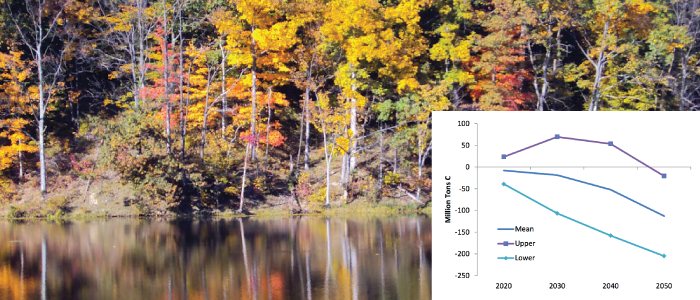Above: Net carbon change in forests due to the EISA 2007 biofuel mandate and 95 percent confidence intervals based on a Monte Carlo simulation analysis.
Biofuels, fuels derived from plant materials, have the potential to reduce the United State’s dependency on fossil-based fuels. Brent Sohngen, professor of Agricultural, Environmental and Development Economics at The Ohio State University, and his colleagues have developed a series of land use and management models that assess, among many issues, the impact of using forests for biofuel.
With the help of the Ohio Supercomputer Center, Sohngen is building on these previous models to more accurately analyze whether forest-based biofuels are carbon neutral. The results have significant economic implications for the forestry sectors, as the Energy Independence and Security Act (EISA) of 2007 directed the US Environmental Protection Agency to approve biofuel pathways only for carbon-neutral feedstocks.
Sohngen’s preliminary assessment of the EISA 2007 laws were inconclusive. The average result suggests that forests emit carbon under the biofuel mandate scenario, which would eliminate wood products from being used in biofuel production. However, many of the key parameters used in the models are derived from statistical analyses, which are considered uncertain. At the 95 percent confidence level, the results included significant positive changes – making forestry products candidates for biofuels.
Because this situation clouds the confidence-level government policy makers have in the results, the EPA asked Sohngen to develop confidence bands for the results from the global forestry and land-use model.
To do that, Sohngen and his graduate students created a Monte Carlo simulation method for the model, using information on uncertainty in the elasticity parameter used in the land supply functions and in the parameters used in the forest growth and yield parameters. (A computerized mathematical technique, Monte Carlo simulation allows people to account for risk in quantitative analysis and decision making.) The global model includes more than 200 regions and management types, providing for significant heterogeneity.
“Biofuel pathway analyses have traditionally ignored uncertainty,” Sohngen said. “We’ve created one of the first methods to integrate uncertainty analysis, and it is the first implementation of Monte Carlo analysis in this type of land use modeling.
“Monte Carlo analysis with the global forest and land use modeling system routinely require eight to 15 hours on a desktop computer to obtain results. In order to make independent draws on over 1,000 parameters in the model, we need to solve a large number of scenarios. We benefit substantially by having access to the Ohio Supercomputer Center to run many of these computationally intensive scenarios simultaneously,” Sohngen said.
Project Lead: Brent Sohngen, Ph.D., The Ohio State University
Research Title: Global land use modeling
Funding Source: US Environmental Protection Agency Office of Transportation and Air Quality
Website: http://aede.osu.edu/our-people/brent-sohngen

